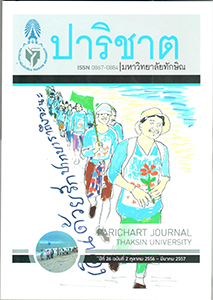ปัจจัยสนับสนุนการเป็นโรงเรียน สิ่งแวดล้อมศึกษาเพื่อการพัฒนา อย่างยั่งยืนในเขตภาคเหนือตอนบน
Main Article Content
Abstract
การวิจัยครั้งนี้มีวัตถุประสงค์เพื่อศึกษาสภาพและปัจจัยสนับสนุนการ เป็นโรงเรียนสิ่งแวดล้อมศึกษาเพื่อการพัฒนาอย่างยั่งยืนในเขตภาคเหนือตอนบน จากกลุ่มบุคลากรที่มีส่วนเกี่ยวข้อง ประกอบด้วย ผู้บริหารสถานศึกษาครูและ นักเรียน โรงเรียนสิ่งแวดล้อมศึกษาในเขตภาคเหนือตอนบน 4 จังหวัด คือ จังหวัดเชียงใหม่ จังหวัดเชียงราย จังหวัดพะเยา และจังหวัดลำพูนกลุ่มตัวอย่าง ได้แก่ ผู้บริหาร ครูและนักเรียนจำนวน 506 คน เครื่องมือที่ใช้ในการวิจัย คือ แบบการสำรวจทุนเดิมของโรงเรียนสิ่งแวดล้อมศึกษาเพื่อการพัฒนาอย่างยั่งยืน และแบบสัมภาษณ์ปลายเปิดแบบมีโครงสร้าง โดยใช้แนวทางการพัฒนาตาม กรอบของกรมส่งเสริมคุณภาพสิ่งแวดล้อมจำนวน 4 ด้าน ได้แก่ 1) ด้านนโยบาย สงิ่ แวดล้อมและโครงสร้างการบรหิ ารจดั การ 2) ด้านกระบวนการจดั การเรยีนรู้ 3) ด้านระบบการจัดการทรัพยากรและสิ่งแวดล้อม และ 4) ด้านการมีส่วนร่วม และเครือข่ายสิ่งแวดล้อมศึกษา โดยผู้วิจัยเก็บข้อมูลและวิเคราะห์ข้อมูล โดย วิธีการวิเคราะห์เนื้อหาและสรุปสาระสำคัญ นำเสนอโดยวิธีการพรรณนา
ผลการวิจัย สรุปได้ว่าปัจจัยที่สนับสนุนการเป็นโรงเรียนสิ่งแวดล้อม ศึกษาเพื่อการพัฒนาอย่างยังยืน ในเขตภาคเหนือตอนบน ประกอบด้วยปัจจัย ที่สำคัญทั้งหมด 8 ด้าน ดังรายละเอียดต่อไปนี้ 1) ปัจจัยด้านหลักสูตรใน โรงเรียนสิ่งแวดล้อมศึกษา โรงเรียนมีลักษณะเป็น Cross-Curriculum คือ ทุกวิชาต้องการบูรณาการแนวคิดเกี่ยวกับสิ่งแวดล้อมศึกษาเข้าไปในเนื้อหา วิชานั้นๆ นอกจากนี้กระบวนการเรียนการสอนมีการเน้นผู้เรียนเป็นศูนย์กลาง และจัดกิจกรรมที่เน้นประสบการณ์ให้ผู้เรียนสร้างความรู้ด้วยตนเอง 2) ปัจจยั ด้านกิจกรรมเสริมหลักสูตร โรงเรียนฯมีการจัดชมรมเกี่ยวกับสิ่งแวดล้อม จัดกิจกรรมต่างๆเพื่อส่งเสริมการเรียนรู้เพิ่มขึ้น 3) ปัจจัย ด้านผู้เรียน การจัด สิ่งแวดล้อมศึกษา โรงเรียนมีการเน้นให้ความสำคัญกับเด็กในนักเรียนโดย เฉพาะอย่างยิ่งกับนักเรียนประถมศึกษา เพราะหากมีการปลูกฝังเรื่องสิ่ง แวดล้อมศึกษาอย่างจริงจังแล้ว เมื่อเด็กเหล่านี้เติบโตขึ้น จะทำให้เกิดความ ตระหนักและจิตสำนึกที่ดีในการร่วมป้องกันและรักษาสิ่งแวดล้อม 4) ปัจจัย ด้านการบริหารงานสิ่งแวดล้อมในโรงเรียน โดยจัดให้มีการส่งเสริมสนับสนุน ในการเผยแพร่ข่าวสาร การประชาสัมพันธ์ด้านสิ่งแวดล้อมให้แก่ ครู นักเรียนผู้ปกครอง ชุมชนในท้องถนิ่ 5) ปัจจยั ด้านกิจกรรมรณรงค์และรักษาสิ่งแวดล้อม โรงเรียน โดย การจัดให้มีกิจกรรมการอนุรักษ์สิ่งแวดล้อมของโรงเรียนและชุมรมอนุรักษ์สิ่งแวดล้อมขึ้น มีการสอดแทรกกิจกรรมในโรงเรียนให้กับครู นักเรียน รวมทั้งการส่งเสริมการใช้สิ่งของหรือ วัสดุ ที่ไม่ก่อให้เกิดปัญหาและเป็นมลพิษต่อสิ่งแวดล้อม 6) ปัจจัยด้านความร่วมมือโรงเรียน กับชุมชน โดยโรงเรียนฯ มีการให้บริการด้านข้อมูลข่าวสาร ความรู้ด้านสิ่งแวดล้อมผ่านครู นักเรียนปสู่ชุมชนในท้องถิ่นและทางโรงเรียนและนักเรียนได้มีก ารออกเยี่ยมชุมชนในท้องถิ่น เพื่อให้ข้อมูลข่าวสารด้านสิ่งแวดล้อม 7) ปัจจัยด้านบรรยากาศและสภาพแวดล้อมของ โรงเรียนมีการจัดเตรียมสถานที่ต่างๆ เช่น ห้องเรียน ห้องสมุดแหล่งการเรยี นร้ภู ายในโรงเรยี น ให้ดูสะอาดเรียบร้อย มีระเบียบ โดยมีการจัดสถานที่ให้เอื้ออำนวยต่อการเรียนการสอน 8) ปัจจัยด้านสัมพันธภาพระหว่างบุคคลในโรงเรียน มีการจัดตั้งชุมนุมอนุรักษ์สิ่งแวดล้อม โดยสร้างเครือข่ายให้เกิดขึ้นระหว่างโรงเรียนกับชุมชนในท้องถิ่น ในการอนุรักษ์สิ่งแวดล้อม โดยมีการเปิดโอกาสให้ ครู นักเรียน ผู้ปกครอง และชุมชนในท้องถิ่น ได้มีการแสดงออก ในกิจกรรมร่วมกัน
Supporting Factors for the Development of Environmental Schools for Sustainable Development (Eco-Schools) in upper North Region.
Suthipong Niphatthananoonth and Manus Suwan
This research aims to study and support the school’s environmental education for sustainable development in the Upper North. The target group comprised of school administrators, teachers and students. The schools of environmental studies in the northern provinces locate in Chiang Mai, Chiang Rai, Phayao and Lamphun. The sample consisted of 506 students, teachers and administrators. The tools used in this study were background survey of the existing school of environmental education for sustainable development and the structured openended interviews, by using guidelines developed by the department of environmental quality promotion in 4 areas: 1) the environmental policy and structural management 2) the process of learning 3) the management of resources and environment, and 4) the participation and environmental education network. The research data were collected, analyzed and summarized by descriptive methods.
The results can be concluded that the factors, contributed to be the school of environmental education for sustainable development in the upper north, include eight important factors as described in the followings: 1) The curriculum in the school of environmental studies, the Cross-Curriculum, means that all subjects need to be integrated with environmental concepts into the course content. In addition, the teaching process emphasized on learner-centered and experience enhancing activities. 2) The extracurricular activities; the school supported on the small group studied about the environment and awareness or consciousness enriching activities. 3) The learners; The elementary level students were especially emphasized on environmental issues so that they would grow up with environmental concerning attitude. 4) The environmental management; the school supported and publicized environmental concerns with teachers, students, parents and local communities. 5) Campaigns and preservation of school environment; the school set up environmental conservation programs to increase level of environmental conservation in the schools. There was interpolation of school activities for students, teachers, and promoting use of environmental friendly materials. 6) The participation of communities and schools; the environmental information and services were publicized throughout students, teachers and the local community. Besides, schools and students had visited the local community to provide environmental information. 7)The atmosphere and environment of the school; classrooms, libraries, learning resources within the school had been rearranged for environmental education. 8) The relationship of the crews in the schools; Small groups of environmental conservation were founded in order to build networks between schools and the local communities, that created opportunities for teachers, students, parents and the local community sharing their environmental activities together.


